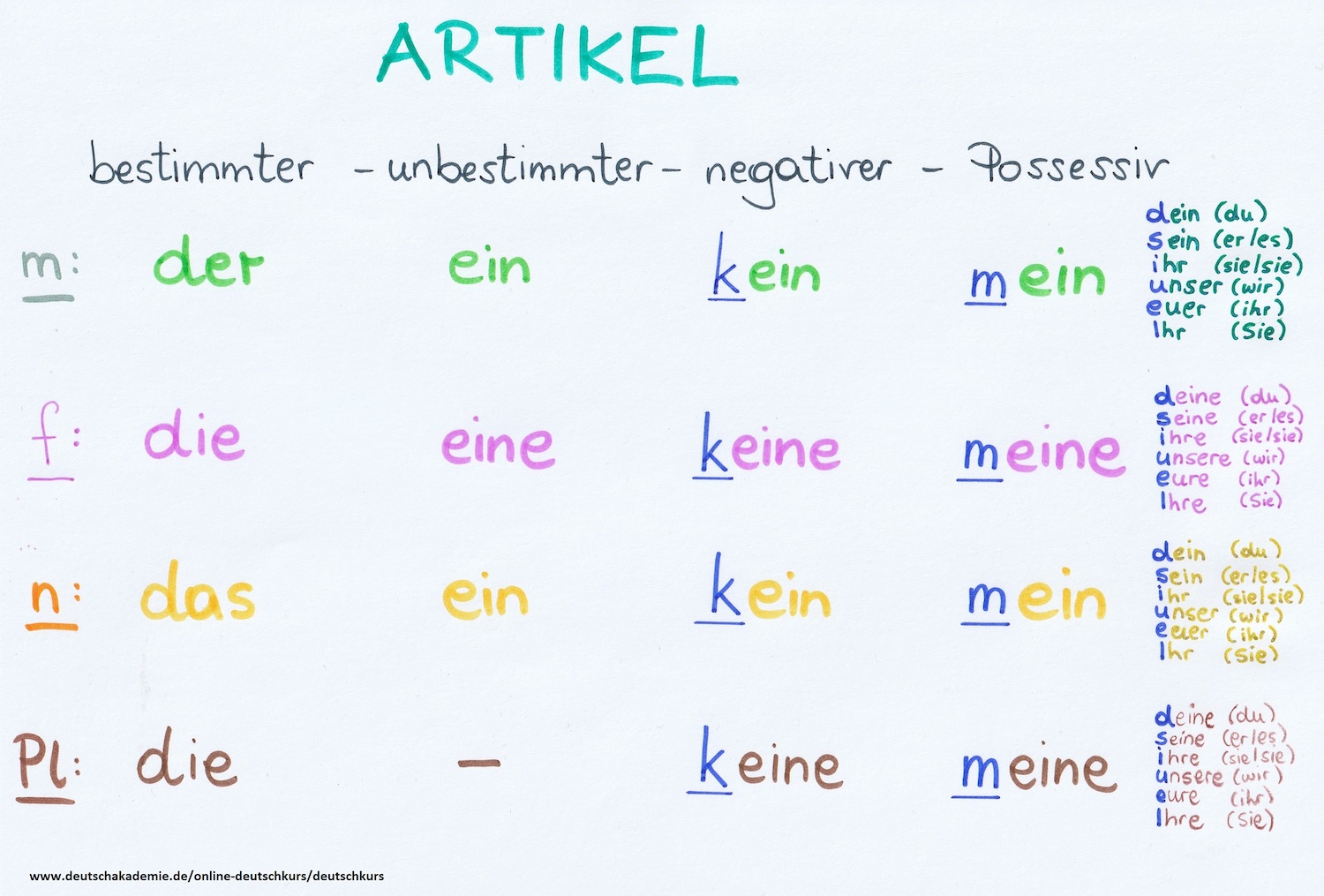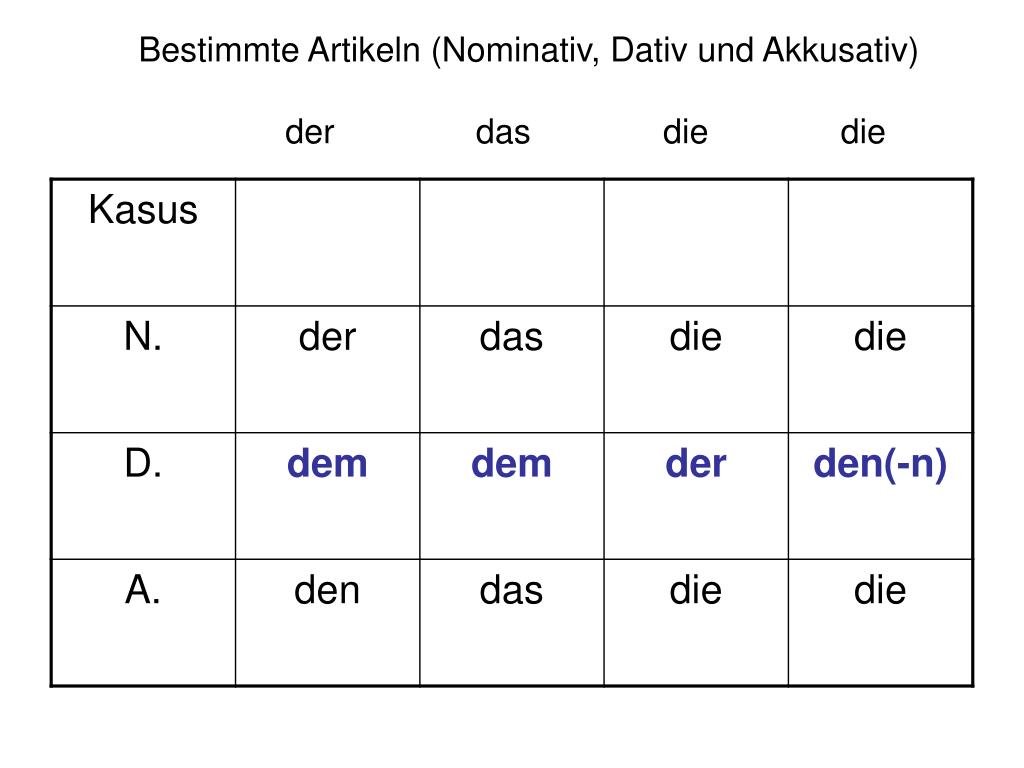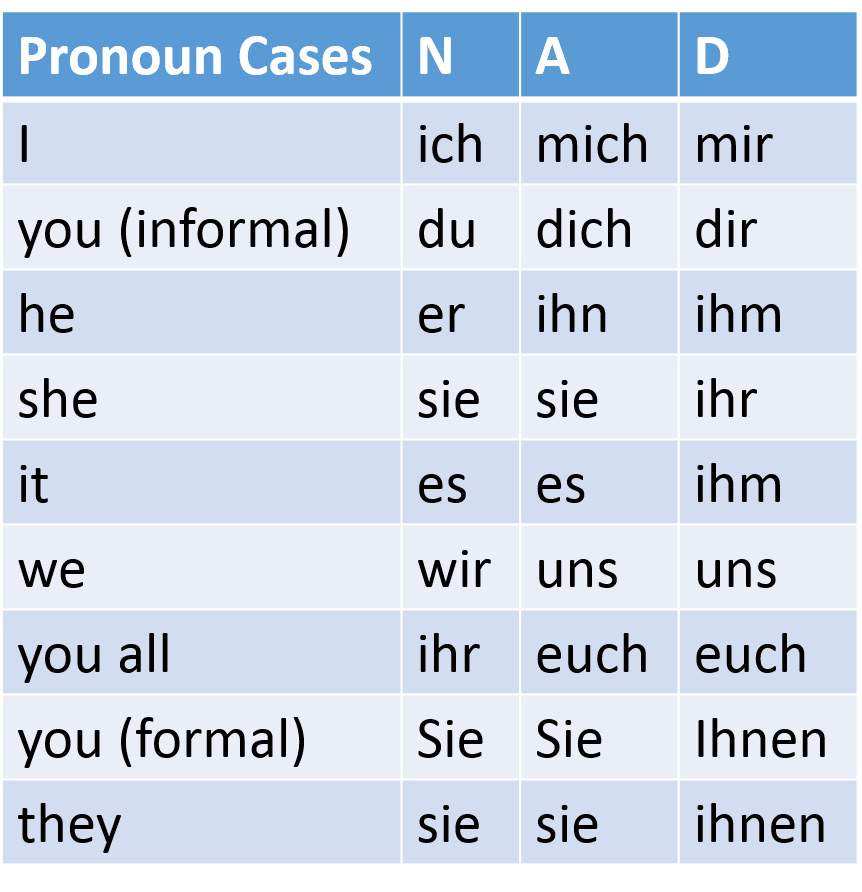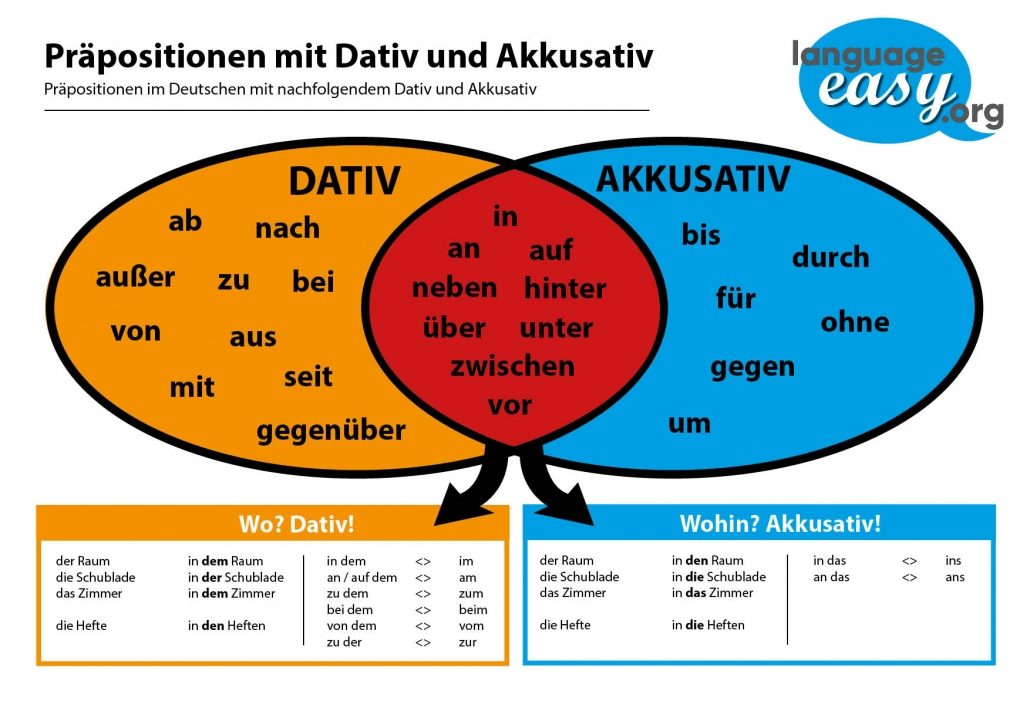
SOLUTION Th nominativ akkusativ dativ Studypool
In German, there are four different forms or categories (cases), called Fälle or Kasus. Two of these cases are the nominative and the accusative. der Nominativ: The subject is always in the nominative case. The articles take the form: der/ein, die/eine, das/ein, die/-. der Akkusativ: Most objects are in the accusative case.

A1, A2, B1 Übungen Deutsch lernen Nominativ, Akkusativ, Dativ Artikel, der, die, das, den
The subject of a sentence is always Nominativ. I am a boy N. Ich bin ein Junge. Subject : I - > Ich -> Nominativ. The apple is red. Apple - der Apfel. Der Apfel ist rot. Subjekt -> der Apfel-> Nominativ . Akkusativ: ->Conveys the direct object in a sentence, person or animal or object being affected by an action carried out by subject in a.

Dativ Akkusativ Erklärung (3. oder 4. Fall) Kostenloser Online Deutschkurs DeutschAkademie
German has "only" 4 cases: Nominative (Nominativ) Accusative (Akkusativ) Dative (Dativ) Genitive (Genitiv) Other languages have a way more! Hungarian: 18 cases. Finish: 15 cases. So take it positive and appreciate that you only have to learn four cases.

über Akkusativ Oder Dativ
The adjective endings - en, - e, and - es correspond to the articles den , die, and das respectively (masc., fem., and neuter). Once you notice the parallel and the agreement of the letters n , e , s with den , die , das, it makes the process a little clearer. Many German learners find the DATIVE (indirect object) case to be intimidating, but.

PPT Personalpronomen im Nominativ und Akkusativ PowerPoint Presentation ID6044032
We'll demystify the four cases with German preposition charts and other essential tools. Stay tuned to learn about: The nominative case, which focuses on the subject of a sentence. The accusative case, which deals with the direct object. The dative case, which highlights the indirect object. The genitive case, which shows possession and other.

Deutsch Personalpronomen Nominativ/ Akkusativ / Dativ YouTube
the subject (Nominativ) does the direct object (Akkusativ) related to the indirect object (Dativ) examples: Den Brief, kannst du (ihn) (mir) bringen, kannst du (ihn) (mir) schreiben? Verbs with Genitiv: rarely used, usage sounds a bit stiltet, often written language, point out to a reason or origin, have often also an Akkusativ version:

Nominativ / Akkusativ / Dativ Deutsch DAF Arbeitsblätter pdf & doc
But in the first sentence, the man ("he") is nominative, whereas in the second sentence, the man (now "him") is accusative. The change in cases from nominative to accusative means that the pronoun referring to the man changes. Let's look at this in a bit more detail now, so that you can figure out the difference between the German.

Nominativ/Akkusativ/Dativ Deutsch Viel Spass
Akkusativ The accusative case. As you may have heard before, there are 4 grammar cases in German: nominative (Nominativ), accusative (Akkusativ), dative (Dativ) ,and genitive (Genitiv). Even though English does not have declensions, German cases have some correspondences with our English grammar features.

Artikel, der, die, das, den, dem, des, Nominativ, Akkusativ, Dativ, Genitiv, Tabelle, Beispiele
The Basics - Nominativ, Akkusativ oder Dativ? (Oder Genitiv?) To be able to follow this step-by-step guide you should have gone through all of the following topics already: The 4 German Cases (Nominative, Accusative, Dative und Genitive) Prepositions; Verbs with Complements; This guide is a summary of all the rules in a way that is easy to put.

Deutsch Übersicht der Personalpronomen im Nominativ, Akkusativ, Dativ und Reflexivpronomen YouTube
In diesem Video erkläre ich, wann wir Nominativ, Akkusativ, Dativ und Genitiv brauchen. Was ein Subjekt ist und wann wir zwei Mal den Nominativ im Satz haben.

Relativpronomen Nominativ Akkusativ Dativ
The difference between accusative and dative in German. by Brita Corzilius Published on December 31, 2020 / Updated on November 7, 2022

Die Fälle Nominativ, Akkusativ, Dati… Deutsch DAF Arbeitsblätter pdf & doc
The Dative Case (Der Dativ or Der Wemfall) The dative case is a vital element of communicating in German. In English, the dative case is known as the indirect object. Unlike the accusative, which only changes with the masculine gender, the dative changes in all genders and even in the plural. The pronouns also change correspondingly.

German Lesson 6 Akkusativ and Dativ Pronouns Language Exchange Amino
The four German cases are nominative, accusative, dative, and genitive. The nominative case is used for sentence subjects. The subject is the person or thing that does the action. For example, in the sentence, "the girl kicks the ball", "the girl" is the subject. The accusative case is for direct objects.

Die 4 Fälle im Deutschen alles über Nominativ Akkusativ Dativ Genitiv
The Nominative Case (Nominativ) is the Basic form of the Noun and describes the Subject of the sentence (the Person or Thing that is acting or being talked about).. Akkusativ (Accusative) Dativ (Dative) Genitiv (Genitive) The following things need to be adjusted (declined) based on the case:

Nominativ, Akkusativ , Dativ تعليم اللغة الالمانية الدرس السادس قواعد YouTube
Relativpronomen - Nominativ/Akkusativ/Dativ (1) B1 Relativpronomen - Nominativ/Akkusativ/Dativ (2) B1 Relativpronomen - alle (1) C1 Relativpronomen - alle (2) C1; A1 Beginner A2 Elementary B1 Intermediate B2 Upper intermediate C1 Advanced. Grammar Tenses Verbs Verb Conjugator Nouns and Articles Pronouns.

Kasus (nominativ, akkusativ, dativ)… Deutsch DAF Arbeitsblätter pdf & doc
Personalpronomen - Nominativ, Akkusativ, Dativ (2) A2 Personalpronomen - Nominativ, Akkusativ, Dativ (3) B1 Personalpronomen - Nominativ, Akkusativ, Dativ (4) B1; A1 Beginner A2 Elementary B1 Intermediate B2 Upper intermediate C1 Advanced. Grammar Tenses Verbs Verb Conjugator Nouns and Articles Pronouns.